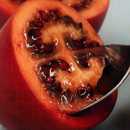Wasabi |
Wasabia japonica |
| |
||
 |
||
 |
||
 |
||
Wasabi is part of the Brassicaceae family. This also includes cabbages, horseradish and mustard. Native to Japan and is traditionally found growing in or by cold mountain streams. Low growing rhizome plant with lush green canopy. This root or rhizone is a staple condiment of Japanese culture.
Landscape Value
A must for all fans of Japanese food. Grow handy to the kitchen or add to your corner of the garden that is cool, lush and wet.
Nutritional Value
A real Superfood! It contains fibre, protein and energy. High levels of calsium, iron, magneewium, phosphorus, potassium, sodium and zinc. Rich in vitamin A, B & C. Also high in anti-oxidants and low in cholestrol. What does this food not have?
How to Eat
Wash and trim the rhizone removing any bumps. Holding the leafy end of rhizone grate wasabi. Let it rest for a couple of minutes for the flavours to develop and serve. Note Wasabi loses is flavour very quickly after 15-20 minutes once exposed to the air. Wasabi has a strong hot intense flavour that disappears leaving a sweet taste with no burning sensation. Ideal for sushi and other fish dishes. The leaves can be used in salads like other leafy vegetables. They have a slight mustard flavour and not as intense as the rhizone. The leaves can also be dried to use later in foods as a seasoning.
Expected Yield
One rhoizone per plant.
Growing
Sun
Shaded to Semi-shaded position with plenty of mositure.
Wind
Not wind tolerant
Salt
Not salt tolerant
Climate
Humid and damp environment. Planting beside a stream or pond is ideal.
Soil
Free draining soil.
Fertiliser
Through the growing season fertilise regularly with a liquid fertiliser.
Pruning
No pruning.
Pests
Make sure the soil is free draining and the plant is not over exposed to sunlight.
Hardiness
No. Must be kept within the temperatures of 7 - 21 degrees C.
Special Conditions


